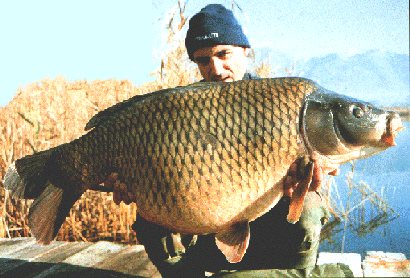|
Carp fishing today is for trophies. Public and private lakes and ponds specialize in this type of fishing and for these lakes to get a good reputation large fish have to be illegally obtained. The large specimens are at least 10 years old and are not available in the regular freshwater fish trade. Even if carp production does involve large quantities it mainly concerns fish of 1 to 3 kilos for consumption or restocking. Breeders cannot keep carp for 10 years to get fish weighing 10 kilos as there may no longer be a market for them when the time comes to sell them? The only large specimens available come from waters which have not been fished for more than 10 years… They remain scarce and there are few available.
The best way to obtain these large carp is to buy them from fishermen! It is illegal but this trade does exist!
This illegal traffic is organised and there are even advertisements on the Internet. It is not unusual to observe the disappearance of fish after drainage of lakes and ponds renowned for large carp. Where have they gone?
The United Kingdom was one of the first countries to act against this illegal trade. Fish (carp, wels and sturgeons) are entering illegally from France, Belgium, the Netherlands and also from Eastern European countries. Stephen Maidment from the Weymouth laboratory believes that offences are committed in England by owners of fisheries in order to attract anglers who are ready to pay large sums of money to catch bigger fish than would otherwise be available. There is the well known case of a carp weighing 20 kilos which was sold for £5000 (7200 euros) in England after being purchased for £100 (150 euros) in Eastern Europe.
The United Kingdom and many other European countries have set up legislation to combat this phenomenon with the mandatory requirement of a movement/health certificate for the transport of fish but this legislation is difficult to enforce. The most bothersome disease is spring viraemia of carp which affects carp and can kill young fish but older fish are not affected although they may carry the virus. The problem is how to implement such a specific requirement for carp when they are easy to transport.
Other measures have been set up: in France is is prohibited to sell catches since 1985, in Belgium containers of over 12 litres (a bucket) are no longer authorized to transport live fish. In France it will become mandatory to put fish back in the water on the spot immediately after capture (at night). Will these measures have any impact? It should be noted that carp fishing groups and clubs condemn this trade and are trying to stop it. The European Anglers Alliance has relayed the demands of member countries. Only international regulations will be really effective but the uncertainty may well remain owing to the attraction of large sums of money.
Top
|
